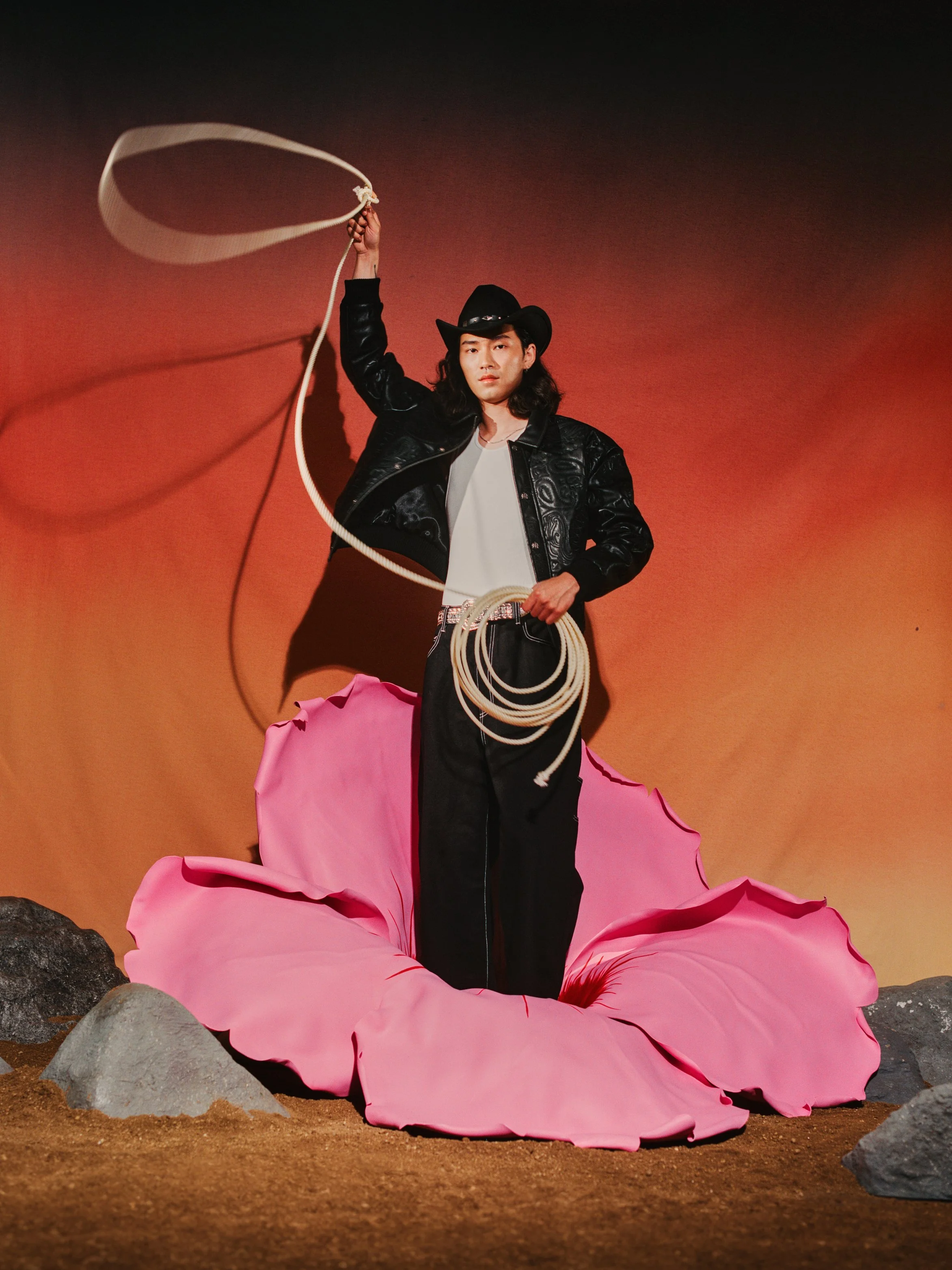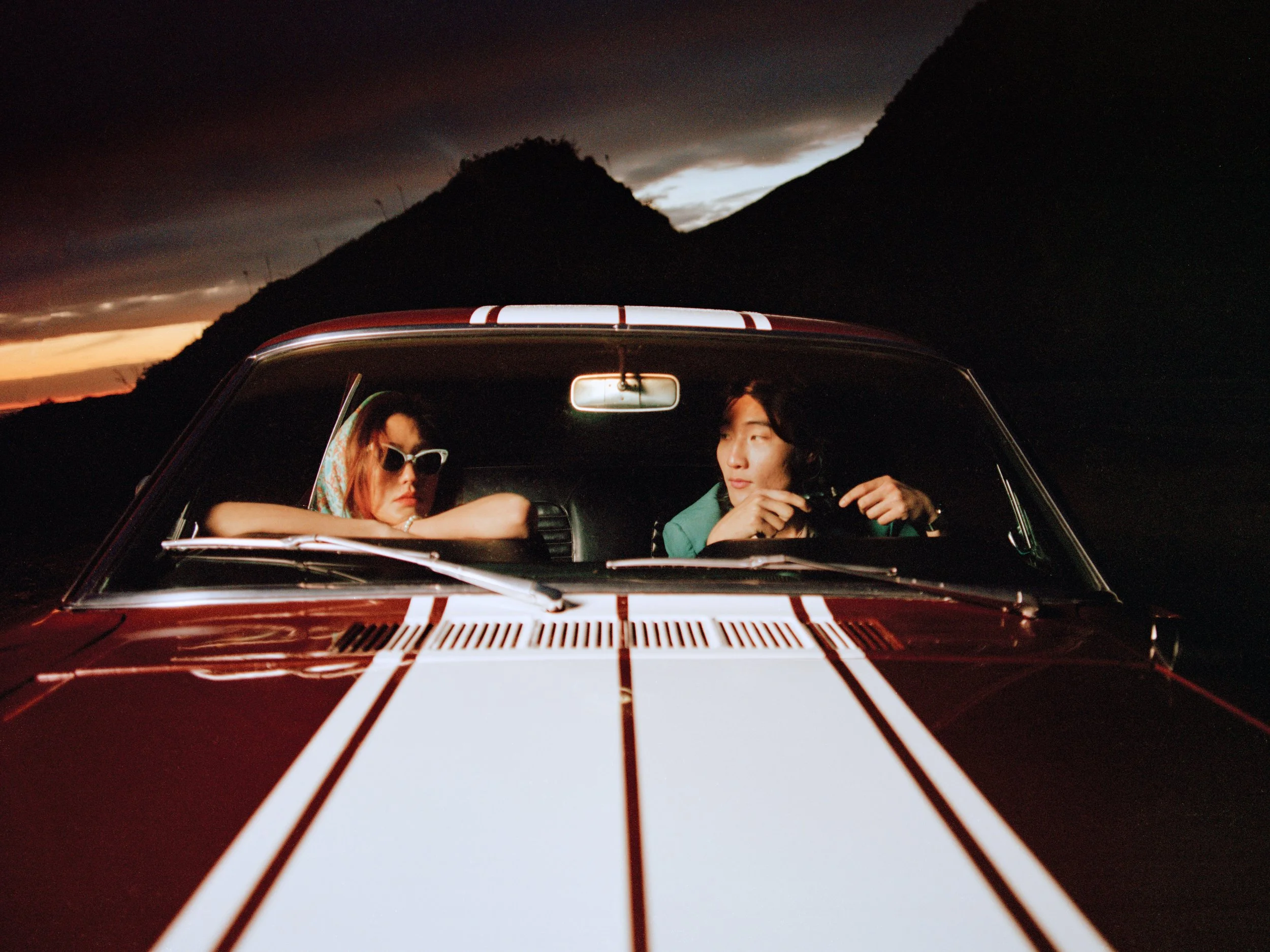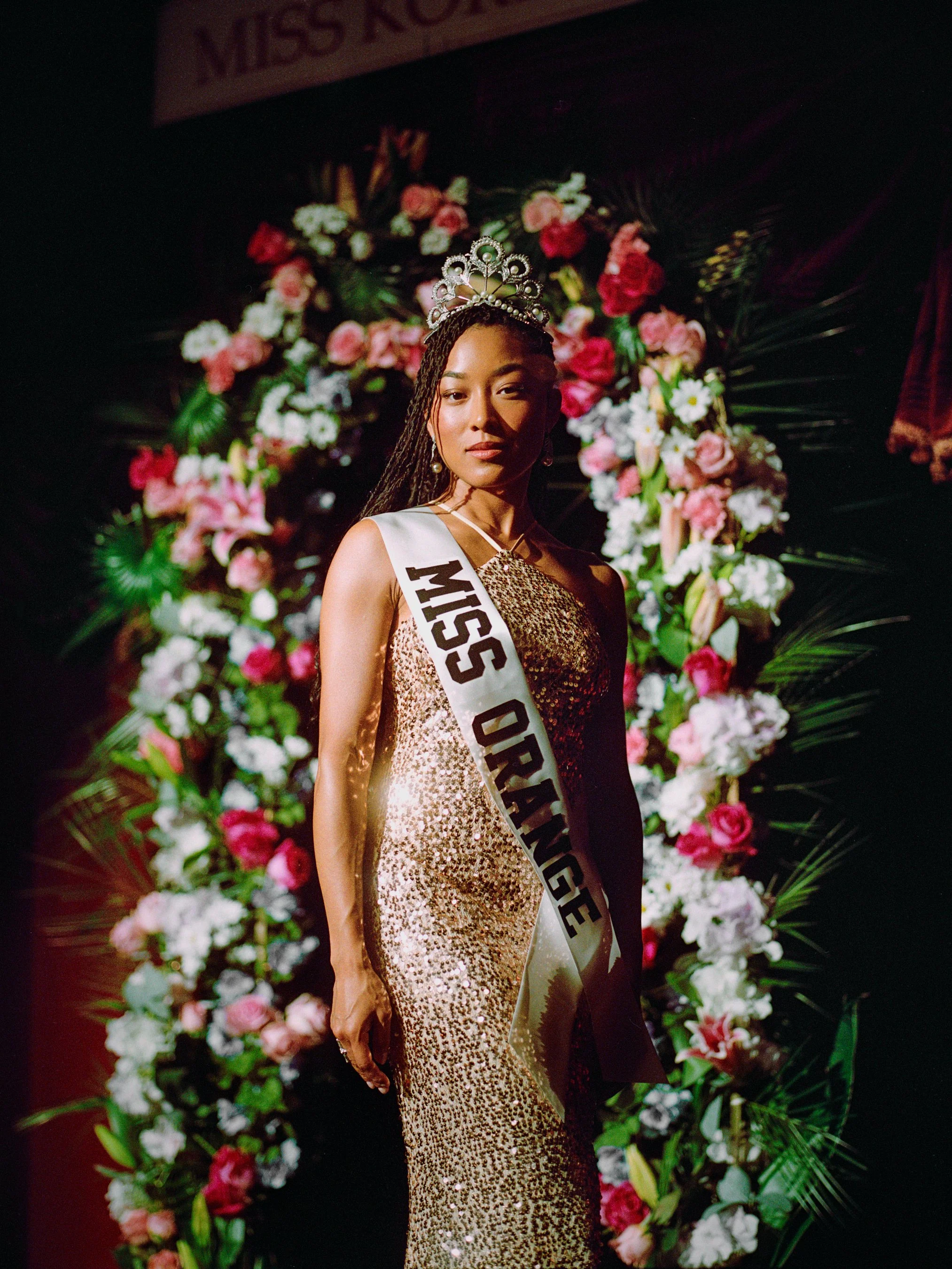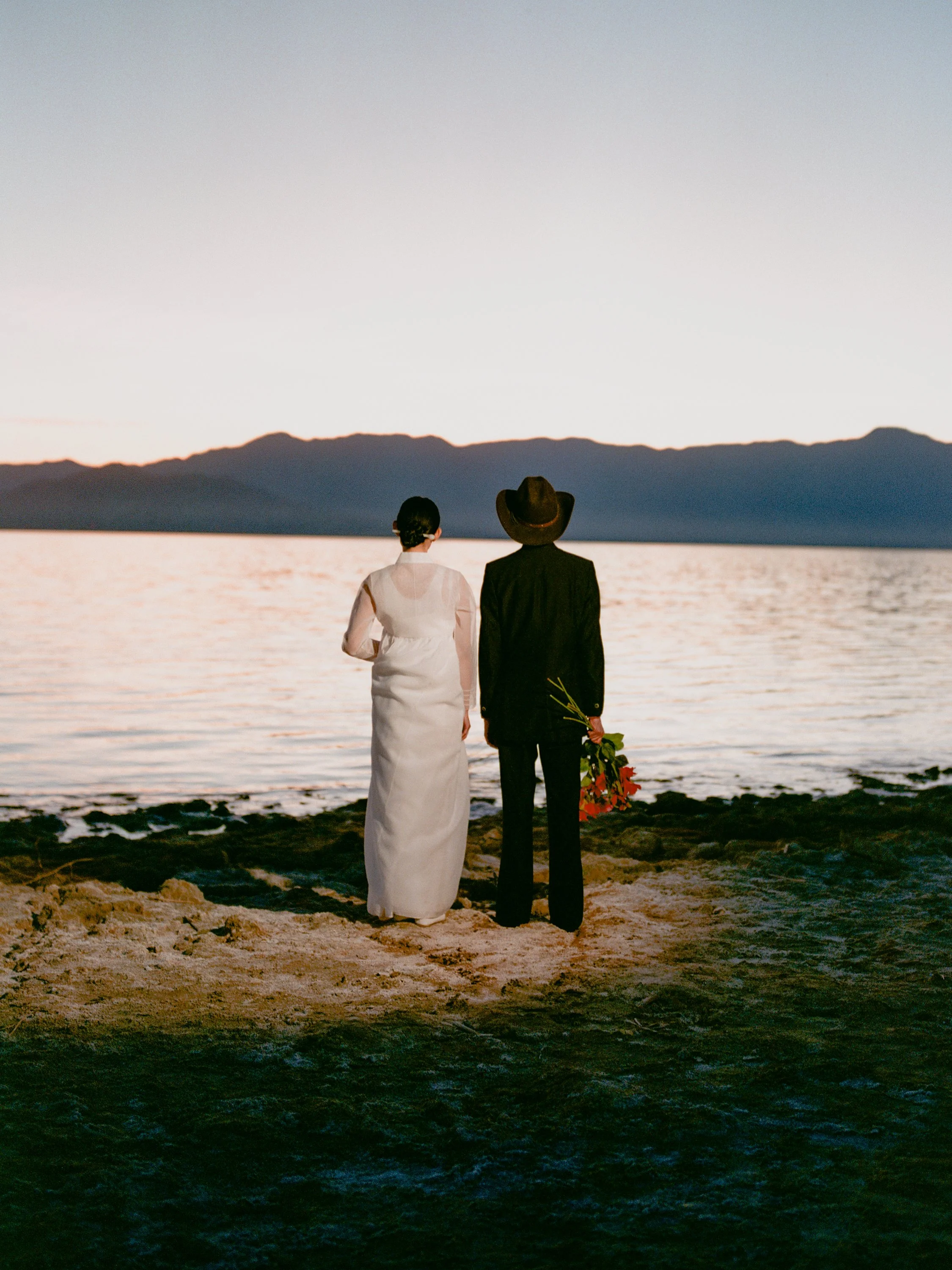America Fever is a staged narrative series that intersects Korean cultural elements with the myth of the American West, centering on post-war Korean American immigrant experiences. The title, derived from 미국병, evokes the feverish desire of Koreans to immigrate, inspired by the image of American culture.

In a harsh desert, standing against the backdrop of the South Korean flag painted in the style of hwatu, a common gambling card game, a young immigrant couple steps forward uncertainly into their new future. The act of immigration for a new life is in itself a gamble. The set design, complete with fake plants from a prop house, reflects the artificiality of Hollywood, which produced media that enticed Korean immigrants to the United States.

Jultagi references a historical Korean performance in which an entertainer tells witty stories while walking a tightrope. A man dressed in Western clothes leaps towards the camera, and his future, while a woman, dressed in traditional Korean attire, has her back turned, reflecting longingly on her past. The tightrope acts as a metaphor for the immigrant experience where there’s little room for mistakes. Assimilating into this new culture often meant diminishing one’s past and performing “Americanness” to fit in.

Borrowing from Sandro Boticelli’s The Birth of Venus, an enlarged mugunghwa (무궁화), the national flower of South Korea, serves as a platform for the emergence of our figurine dressed in a modern hanbok and holding a bottari, alluding to migration. The species of the hibiscus, rose of sharon, has Biblical allusions pointing to its ability to bloom in the desert, signaling the resilience and fortitude of the Korean American diaspora in a harsh and foreign land.

Borrowing from Sandro Boticelli’s The Birth of Venus, an enlarged mugunghwa (무궁화), the national flower of South Korea, serves as a platform for the emergence of our figurine dressed in western wear and throwing a lasso signals the readiness to tackle the challenges of a new world. The species of the hibiscus, rose of sharon, has Biblical allusions pointing to its ability to bloom in the desert, signaling the resilience and fortitude of the Korean American diaspora in a harsh and foreign land.

“Boy's Trip” is a re-imagining of the typical American western road trip with an Asian-American cast. Inspired by photos of Asian American men in the 80s hanging out and enjoying themselves, this image shows a group of young men out in the desert, getting lost, exploring and then returning home. Placing Asian faces and bodies in a wild desert landscape re-creates a quintessentially western scene as an inclusive space for this country's newer immigrants.

“Boy's Trip” is a re-imagining of the typical American western road trip with an Asian-American cast. Inspired by photos of Asian American men in the 80s hanging out and enjoying themselves, this image shows a group of young men out in the desert, getting lost, exploring and then returning home. Placing Asian faces and bodies in a wild desert landscape re-creates a quintessentially western scene as an inclusive space for this country's newer immigrants.

Inspired by rebellious motorcycle gangs like the Hells Angels and Dennis Hopper’s Easy Rider, this image portrays a group of young bikers out for a day of fun in the Angeles National Forest. Motorcycles were yet another symbol of the freedom that the the United States inspired in young immigrants - visions of the wide open country and majestic terrains of the west where once could get lost.

Inspired by rebellious motorcycle gangs like the Hells Angels and Dennis Hopper’s Easy Rider, this image portrays a group of young bikers out for a day of fun in the Angeles National Forest. Motorcycles were yet another symbol of the freedom that the the United States inspired in young immigrants - visions of the wide open country and majestic terrains of the west where once could get lost.

Enticed by depictions of the American Dream, many Koreans in the post-war era were inspired to move to the US, which advertised itself through pop culture, fashion, and sleek sports cars. Inspired by Jim Jarmusch’s Mystery Train, here we see a young couple getting lost in the mountains of California, as they take out their Ford Mustang for a spin, documenting the process for friends and family back home.

Enticed by depictions of the American Dream, many Koreans in the post-war era were inspired to move to the US, which advertised itself through pop culture, fashion, and sleek sports cars. Here, a young couple, newly immigrated to the United States, enjoys a taste of an idealized vision of Americana as they stare into the impressive Malibu sunset in front of their Ford Mustang.

Enticed by depictions of the American Dream, many Koreans in the post-war era were inspired to move to the US, which advertised itself through pop culture, fashion, and sleek sports cars. Referencing road trip movies by Jim Jarmusch and Wim Wenders, here we see a young couple, newly immigrated to the United States, enjoying a taste of an idealized vision of Americana as they sit in a Ford Mustang as the sun sets behind the impressive Santa Monica mountains behind them.

Drawing from the artist’s own itinerant upbringing across multiple countries, the mother became an important connection for the artists to his Korean heritage. The mother, wearing a traditional hanbok represents the source of Korean culture and education, while the son’s cowboy outfit represents his life in the West.

Inspired by Korean beauty pageants of the ‘80s and ‘90s in Korean communities in the United States, the beauty pageant is reimagined by featuring mixed-race contestants, evolving our notions of Korean beauty. The sashes indicate the various fruits and crops that Korean immigrants were involved in growing: Sugar (in Hawaii), Oranges (California), and Cabbage (numerous States). The mixed-race contestants reflect the diversity of Los Angeles, one of the most attractive destinations for immigrants.

Inspired by Korean beauty pageants of the ‘80s and ‘90s in Korean communities in the United States, this series reimagines the beauty pageant by featuring mixed-race contestants, evolving our notions of Korean beauty. The sashes indicate the various fruits and crops that Korean immigrants were involved in growing: Sugar (in Hawaii), Oranges (California), and Cabbage (numerous States). The mixed-race contestants reflect the diversity of Los Angeles, one of the most attractive destinations for immigrants.

During the Korean War, many American soldiers bore children with Korean women. Mixed children were often ostracized by both Korean and American society, leading to many abandoned orphans. This image shows an interracial family jumping rope, symbolizing hope and better days for the next generation.

A newly arrived couple looks past at a serene body of water towards the intimidating mountains ahead, as they contemplate where they came from and where their ambitions leads them. This location, Salton Sea, which was once a thriving vacation destination for the rich and famous that turned into a toxic dead lake, serves as a symbol for the dashed dreams of many immigrants.

Drawing on the delusional journey of Don Quixote, and borrowing from surrealist painters like René Magritte and Jane Gaverol, a man is depicted at the twilight of his immigrant journey as he sits on a chair, flanked by a younger woman, who’s about to start on her own. The horse represents passageway into the afterlife and the man is surrounded by symbols of death such as the crow and snake. The young woman, covered in chainmail, fortified by the sacrifices of the previous generation, is ready to take on the new challenges ahead.

Drawing on the delusional journey of Don Quixote, and borrowing from surrealist painters like René Magritte and Jane Gaverol, a man is depicted at the twilight of his immigrant journey as he sits on a chair, flanked by a younger woman, who’s about to start on her own. The horse represents passageway into the afterlife and the man is surrounded by symbols of death such as the crow and snake. The young woman, covered in chainmail, fortified by the sacrifices of the previous generation, is ready to take on the new challenges ahead.

Drawing on the delusional journey of Don Quixote, and borrowing from surrealist painters like René Magritte and Jane Gaverol, a man is depicted at the twilight of his immigrant journey as he sits on a chair, flanked by a younger woman, who’s about to start on her own. The horse represents passageway into the afterlife and the man is surrounded by symbols of death such as the crow and snake. The young woman, covered in chainmail, fortified by the sacrifices of the previous generation, is ready to take on the new challenges ahead.
Exhibitions & Press: